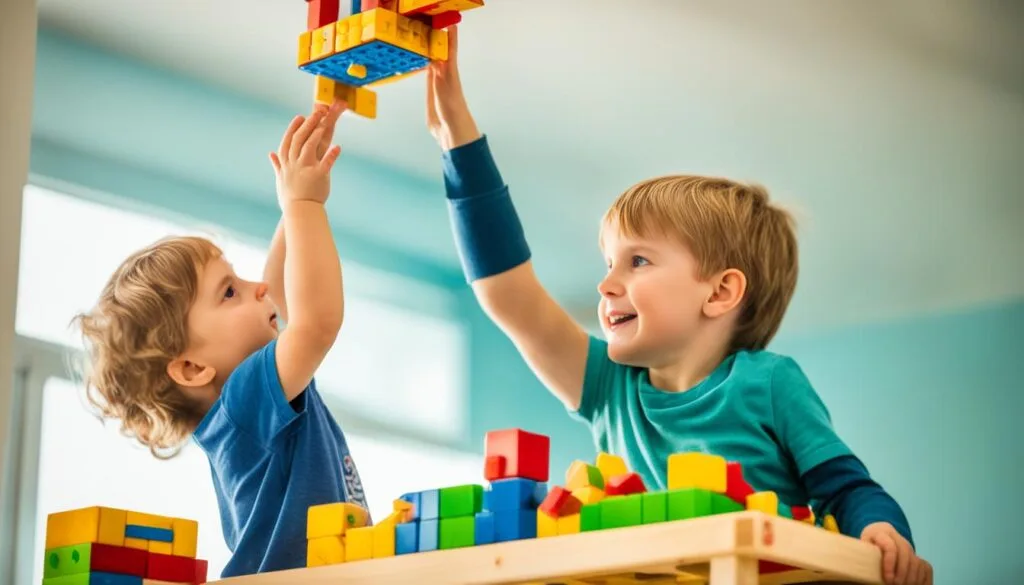Phone:
(+65)8319-0742
Scaffolding is a process in which adults provide just the right amount of support to children in order to help them learn and develop. It involves offering guidance and assistance in a way that allows children to solve problems and accomplish tasks beyond their current abilities. This approach is based on the concept of the zone of proximal development, which was developed by Lev Vygotsky. Scaffolding can be observed in various scenarios, such as play activities and learning tasks, and it plays a crucial role in promoting cognitive development and learning in children.
Key Takeaways:
- Scaffolding provides the right support to help children learn and develop beyond their current abilities.
- It is based on the zone of proximal development, a concept developed by Lev Vygotsky.
- Scaffolding promotes cognitive development and learning in children.
- It can be observed in various scenarios, such as play activities and learning tasks.
- Scaffolding plays a crucial role in supporting children’s growth and development.
The Role of Scaffolding in Cognitive Development
Scaffolding plays a crucial role in promoting cognitive development in children. It acts as a bridge that connects a child’s current abilities to the skills and knowledge they are striving to acquire. By providing the necessary support and guidance, scaffolding enables children to understand complex concepts and problem-solving strategies that they would not be able to grasp independently.
Scaffolding supports the development of cognitive skills such as:
- Critical thinking
- Problem-solving
- Decision-making
Through scaffolding, children are empowered to engage in activities and tasks that go beyond their current capabilities. This guided learning process not only facilitates their cognitive growth but also fosters a sense of confidence and accomplishment.
Here is an image illustrating the role of scaffolding in cognitive development:
| The Role of Scaffolding in Cognitive Development | |
|---|---|
|
|
Social Interaction and Scaffolding in Child Development
Scaffolding is not only about individual tasks and activities but also includes social interactions. Social interaction plays a crucial role in child development as it provides opportunities for children to learn from and with others. When adults scaffold social interactions, they provide support and guidance to help children engage in meaningful and developmentally appropriate social exchanges.
Modeling appropriate social behavior is a key aspect of scaffolding social interactions. By demonstrating how to communicate effectively, share, take turns, and resolve conflicts, adults serve as positive role models for children. This modeling helps children understand expected social norms and behaviors, enabling them to navigate social situations with confidence.
Additionally, providing feedback and guidance during social interactions is an important part of scaffolding. Adults can actively engage in conversations, ask open-ended questions, and provide constructive feedback to help children reflect on their actions and improve their social skills. By giving children specific guidance and highlighting positive behaviors, adults promote self-awareness and social growth.
A conducive environment that fosters positive social relationships is another essential element of scaffolding social interactions. This can be achieved by creating opportunities for collaborative play and group activities, encouraging teamwork and cooperation, and promoting empathy and respect for others. By establishing an inclusive and supportive atmosphere, adults enable children to develop important social and emotional skills.
Through scaffolding social interactions, children not only learn how to navigate social dynamics but also develop crucial social and emotional skills. They learn to communicate effectively, empathize with others, negotiate conflicts, and develop positive relationships. These social milestones are significant indicators of healthy child development.
Milestones in Social Interaction Development
| Age Group | Social Interaction Milestones |
|---|---|
| Infancy (0-12 months) | – Smiling and making eye contact – Responding to familiar voices – Engaging in turn-taking games like peek-a-boo – Displaying social preferences |
| Toddlerhood (1-3 years) | – Engaging in parallel play – Initiating simple social interactions – Expressing emotions and needs verbally – Demonstrating empathy towards others |
| Preschool (3-5 years) | – Engaging in cooperative play – Taking turns and sharing – Engaging in conversations – Understanding and following social rules |
| School Age (6-12 years) | – Forming and maintaining friendships – Understanding social norms and expectations – Collaborating in group activities – Resolving conflicts independently |
By scaffolding social interactions, adults provide children with the necessary support to develop these social milestones and thrive in their social environments. The guidance, modeling, and feedback offered during social interactions lay a strong foundation for healthy social development.
Strategies and Techniques for Scaffolding in Child Development
Implementing effective strategies and techniques is key to successful scaffolding in child development. Educators can employ various methods to provide targeted support and guidance, facilitating children’s learning and development. Here are some commonly used scaffolding techniques:
Asking Prompting Questions
One strategy is to ask open-ended questions that encourage critical thinking and problem-solving. These questions prompt children to reflect on their ideas and explore different solutions. By guiding their thought process, educators can help children develop higher-order thinking skills.
Providing Suggestions and Hints
Another technique involves offering suggestions and hints to guide children’s problem-solving efforts. This approach nudges them in the right direction without giving them the answer directly. It encourages independent thinking and empowers children to come up with their own solutions.
Offering Challenging Activities
Presenting activities just above children’s current abilities provides an opportunity for them to stretch their skills and knowledge. By engaging in moderately challenging tasks, children can build upon their existing competencies and develop new ones. This technique promotes growth and fosters a sense of accomplishment.
Modeling and Demonstrating
Modeling and demonstrating tasks or concepts can be highly effective in scaffolding children’s learning. By providing a clear example, educators show children how to approach a task or understand a concept. This visual demonstration helps children make connections and acquire new skills.
Building off Prior Knowledge and Experiences
Linking new information or skills to children’s prior knowledge and experiences is crucial in scaffolding. By connecting new concepts to what children already know, educators help them make sense of new information and build a solid foundation for further learning.
Encouraging Metacognition
Encouraging children to think about their own thinking, known as metacognition, promotes self-reflection and self-regulation. By asking questions like “How did you solve that problem?” or “Why did you choose that strategy?”, educators help children become aware of their thought processes. This reflection enhances their problem-solving skills and promotes independent learning.
Incorporating these strategies into daily interactions and activities can greatly enhance the effectiveness of scaffolding in child development. By providing tailored support and guidance through these techniques, educators can foster meaningful and engaging learning experiences for children.
The Benefits of Scaffolding in Child Development

Scaffolding in child development offers numerous benefits that contribute to children’s overall growth and learning. By providing the right level of support and guidance, educators can foster cognitive development, enhance critical thinking skills, and support individual growth and self-esteem. Scaffolding also plays a vital role in identifying gaps in understanding, allowing for targeted interventions and support.
Promoting Cognitive Development
Scaffolding promotes cognitive development by providing children with the necessary support to learn and understand complex concepts. It helps bridge the gap between a child’s current abilities and the knowledge or skills they are trying to acquire. Through scaffolding, children can engage in activities and tasks that challenge their thinking and problem-solving abilities, leading to the development of higher-order cognitive skills.
Enhancing Critical Thinking and Problem-Solving Skills
Scaffolding guides children through challenging tasks and helps them develop critical thinking and problem-solving skills. By offering strategic interventions and asking prompting questions, educators encourage children to think deeply, analyze information, and explore different solutions to problems. This process of guided learning fosters the development of essential skills that children can apply across various contexts throughout their lives.
Building Confidence and Self-Esteem
Scaffolding supports children’s confidence and self-esteem by providing them with achievable goals and gradually increasing the level of difficulty. When children receive appropriate support and guidance in their learning journey, they experience success and a sense of accomplishment. This positive reinforcement builds their confidence, motivates them to take on new challenges, and fosters a growth mindset.
Supporting Individual Growth
Scaffolding recognizes that each child has unique strengths, weaknesses, and learning styles. It allows children to progress at their own pace and build upon their existing knowledge and skills. By tailoring scaffolding approaches to individual needs, educators provide personalized support that fosters optimal growth and development in each child.
Identifying Gaps in Understanding
Scaffolding helps educators identify gaps in children’s understanding by observing their progress and responses during learning activities. By closely observing children and their interactions, educators can identify areas where additional support or interventions may be needed. This enables targeted interventions to address specific challenges and ensure children’s learning is on track.
Overall, scaffolding is an essential tool in child development interventions and educational practices. Its benefits extend beyond the immediate learning outcomes, as children develop the skills and confidence necessary for lifelong learning and success.
Challenges and Considerations in Scaffolding
While scaffolding is an effective approach in child development, it presents certain challenges that educators need to address. These challenges require thoughtful considerations to ensure successful educational scaffolding and effective child learning strategies.
1. Tailoring Scaffolding Techniques to Individual Needs
One challenge is the need for significant planning time to customize scaffolding techniques to accommodate the specific needs and learning styles of each child. To provide effective scaffolding, educators must thoroughly understand the strengths, weaknesses, and learning preferences of each child. By tailoring their approaches, educators can provide personalized support that maximizes learning potential.
2. Adjusting the Level of Support
Another consideration is the importance of adjusting the level of support to match a child’s progress. It is crucial to strike the right balance – providing neither too much support nor too little. Over-support can hinder a child’s independence and development, while under-support may lead to frustration or a lack of progress. Educators must continuously assess and monitor children’s progress to ensure that the level of support is appropriate at each stage of their learning journey.
3. Ongoing Assessment and Adaptation
Scaffolding requires constant assessment and adaptation. Educators need to regularly evaluate children’s progress and understanding to determine the effectiveness of the scaffolding approach and make necessary adjustments. This ongoing assessment ensures that scaffolding remains aligned with children’s evolving needs and fosters continuous growth and learning.
By addressing these challenges and considering these aspects of scaffolding, educators can enhance the effectiveness of educational scaffolding and child learning strategies, promoting optimal development and academic success.
Understanding the Scaffolded Learning Process

Scaffolding in child development is not a one-time event, but rather a dynamic and evolving process that unfolds over time. It involves observing and understanding children’s abilities, providing appropriate and timely support, and gradually reducing the level of support as children become more independent and competent. The scaffolded learning process is driven by educators who are sensitive to children’s needs and interests, allowing them to actively engage in their own learning.
During the scaffolded learning process, educators carefully assess children’s current abilities and identify their individual strengths, weaknesses, and learning preferences. This information helps them determine the most effective strategies and approaches to scaffold children’s learning and development.
Applying the principles of educational scaffolding, educators provide just the right amount of assistance and guidance to help children progress towards their learning goals. They offer support in a way that enables children to actively participate and make meaningful connections to the content being taught.
As children gain confidence and competence in their learning, educators gradually decrease their level of support, allowing children to take on more independent and self-directed roles in their learning. This process empowers children to build their problem-solving skills, critical thinking abilities, and overall cognitive development.
By understanding the scaffolded learning process, educators can create meaningful learning experiences and foster children’s development in various domains, including cognitive, social, emotional, and physical development.
The table below summarizes the key components and stages of the scaffolded learning process:
| Stage | Description |
|---|---|
| Assessment | Educators assess children’s abilities, strengths, weaknesses, and learning preferences. |
| Support | Educators provide appropriate and timely support to meet children’s specific learning needs. |
| Gradual Reduction | Educators gradually decrease the level of support as children become more independent and competent. |
| Empowerment | Children take an active role in their own learning, building problem-solving and critical thinking skills. |
Through the scaffolded learning process, educators can guide children towards optimal learning and development, ensuring that each child reaches their full potential.
Scaffolding in Early Childhood Education
Scaffolding is a critical element in early childhood education, as it sets the stage for children’s future learning and development. During these formative years, children rapidly acquire new skills and knowledge, and scaffolding plays a vital role in providing support and enhancing their learning experiences. Educators in early childhood settings utilize scaffolding techniques to create nurturing and stimulating environments that foster overall development in children.
Through purposeful interactions, educators engage with children, providing the necessary guidance and assistance to help them navigate various learning tasks. They employ scaffolding strategies that promote cognitive, social, emotional, and physical development. By considering children’s unique needs and interests, educators create meaningful learning opportunities that scaffold their growth in multiple domains.
During this critical period, young children benefit greatly from social interaction as they develop and refine their communication and social skills. Scaffolding extends beyond individual tasks and activities to encompass social interactions, where educators provide support, guidance, and modeling to promote positive social exchanges. By scaffolding social interactions, children develop important social and emotional skills, fostering healthy relationships and reaching key milestones in their development.
Benefits of Scaffolding in Early Childhood Education
The implementation of scaffolding in early childhood education yields numerous benefits for children’s development. Here are some key advantages:
- Promotes cognitive development: Scaffolding enables children to grasp complex concepts and enhances critical thinking skills through guided problem-solving activities.
- Supports social and emotional development: Scaffolding social interactions fosters the development of social skills, emotional regulation, and positive relationships.
- Enhances language and communication skills: As educators engage in purposeful interactions, scaffolding helps children build vocabulary, express ideas, and develop effective communication skills.
- Encourages independence and self-confidence: By providing targeted support, scaffolding allows children to tackle challenges and achieve goals, boosting their confidence and self-esteem.
- Promotes physical development: Scaffolding includes activities that promote fine and gross motor skills, coordination, and body awareness.
Scaffolding has a profound impact on children’s holistic development during the early years, setting a solid foundation for their future learning and success.
Scaffolding and Individualized Instruction
Scaffolding in child development goes hand in hand with the concept of individualized instruction. By carefully observing and assessing each child’s strengths, weaknesses, and learning preferences, educators can tailor their scaffolding techniques to meet the unique needs of each child. This personalized approach ensures that children progress at their own pace and receive support that is specifically designed to suit their current abilities.
Individualized scaffolding recognizes and values the diverse characteristics and abilities of each child, fostering their full potential and facilitating optimal learning and development. It allows educators to provide targeted interventions and adapt their teaching strategies to suit the individual child’s needs. By taking into account the specific learning styles, interests, and abilities of each child, scaffolding can be customized to maximize their learning outcomes.
Benefits of Individualized Scaffolding
Implementing individualized scaffolding in child development interventions offers a range of benefits. Here are some of the key advantages:
- Catering to Individual Needs: By tailoring scaffolding to match the unique needs of each child, educators provide targeted support that addresses their specific strengths, weaknesses, and learning preferences.
- Promoting Engagement and Motivation: Individualized scaffolding increases engagement and motivation by offering tasks and challenges that are both stimulating and achievable for each child.
- Fostering Independence: By gradually reducing support as children become more competent, individualized scaffolding empowers children to become independent learners, capable of tackling complex tasks on their own.
- Building Self-Confidence: When children receive support that matches their abilities, they gain confidence in their own skills and capabilities, boosting their self-esteem and overall well-being.
- Accelerating Learning: The tailored nature of individualized scaffolding accelerates learning by capitalizing on children’s strengths and addressing areas requiring additional support.
The benefits of individualized scaffolding in child development interventions extend beyond academic success. By recognizing and catering to the unique needs and abilities of each child, educators create an inclusive and supportive learning environment that promotes holistic growth and development.
| Traditional Instruction | Individualized Scaffolding | |
|---|---|---|
| Approach | Uniform approach for all children | Targeted approach based on individual needs and abilities |
| Progress | Limited pace of progress due to a one-size-fits-all approach | Increased pace of progress as children receive support suited to their abilities |
| Engagement | Varies among individuals based on their personal interests and abilities | Enhanced engagement through personalized tasks and challenges |
| Confidence | Dependent on conformity to standardized expectations | Increased confidence and self-esteem due to tailored support |
Implementing Scaffolding in Practice
Implementing scaffolding in practice requires educators to have a strong understanding of child development theories, learning strategies, and scaffolding techniques. By incorporating these strategies into their teaching practices, educators can create supportive and responsive learning environments that promote optimal growth and development in children.
Understanding Cognitive Development
When implementing scaffolding techniques, educators need to be familiar with the stages and milestones of cognitive development. They should have a solid grasp of how children acquire and process knowledge, as well as the ways in which individual children approach learning. This knowledge enables educators to tailor their scaffolding efforts to the specific needs and abilities of each child.
Effective Scaffolding Techniques
Applying appropriate scaffolding techniques is essential to achieve desired learning outcomes. Educators should be equipped with a range of strategies that can effectively scaffold children’s learning and development. Some commonly used techniques include:
- Asking open-ended questions that encourage critical thinking and problem-solving skills.
- Providing hints, prompts, and cues to guide children’s understanding and problem-solving efforts.
- Modeling and demonstrating tasks or concepts to facilitate comprehension.
- Breaking down complex tasks into smaller, more manageable steps to promote success.
By utilizing these and other scaffolding techniques, educators can help children engage effectively with learning tasks and enhance their motivation and engagement.
Creating Engaging Learning Environments
Scaffolding is not only about the techniques used but also about creating a supportive and responsive learning environment. Educators should strive to establish an environment that encourages active participation, collaboration, and exploration. This includes providing materials and resources that are developmentally appropriate and engaging for children. By creating an atmosphere that fosters curiosity and inquiry, educators can enhance the effectiveness of scaffolding and facilitate children’s cognitive development.
Incorporating scaffolding techniques into teaching practices enhances children’s engagement, motivation, and learning outcomes. By understanding child development theories, utilizing effective scaffolding techniques, and creating engaging learning environments, educators can effectively implement scaffolding in practice to promote optimal growth and development in children.
The Future of Scaffolding in Child Development

Scaffolding has been a cornerstone in child development and education, providing essential support for children’s learning and growth. As research advances and our understanding of child development theories and learning strategies deepens, the future of scaffolding holds even greater promise.
One area that will shape the future of scaffolding is the integration of technology and digital resources. With the increasing prevalence of digital tools in education, educators can leverage these resources to provide personalized and interactive learning experiences. Technology can offer innovative ways to scaffold children’s learning, providing immediate feedback, adapting to individual needs, and creating engaging learning environments.
Furthermore, as child development theories continue to evolve, educators will refine and adapt their scaffolding practices to align with the latest insights. By staying informed about the latest research and understanding different theories, educators can tailor their scaffolding techniques to better meet the unique needs and learning styles of each child.
It is also important to consider the role of cultural and contextual factors in scaffolding practices. Recognizing and embracing the diverse backgrounds and experiences of children can enhance the effectiveness of scaffolding. Educators must ensure scaffolding strategies honor and respect individual differences, allowing children to build upon their strengths and background knowledge.
The future of scaffolding in child development holds the potential for even more effective and tailored support for children’s learning and development. By capitalizing on technological advancements, embracing evolving theories, and incorporating cultural considerations, educators can create scaffolded learning experiences that empower children to reach their full potential.
Benefits of Technology Integration in Scaffolding
The integration of technology and digital resources in scaffolding brings numerous benefits to child development and education.
| Benefits | Explanation |
|---|---|
| Personalization | Technology allows for adaptive and individualized scaffolding experiences, catering to the specific needs and abilities of each child. |
| Engagement | Interactive digital tools can capture children’s attention and motivation, making the learning process more engaging and enjoyable. |
| Immediate Feedback | Technology provides real-time feedback, allowing children to correct their mistakes and adjust their understanding immediately. |
| Differentiation | Digital resources offer various scaffolding options and strategies, catering to different learning styles and levels of understanding. |
| Access to Resources | Technology offers children access to a vast array of digital resources, allowing them to explore and deepen their understanding of concepts. |
Conclusion
Scaffolding is a powerful and effective approach in child development that empowers children to learn and grow. By providing the right level of support, educators can guide children in acquiring new skills, understanding complex concepts, and developing critical thinking abilities. Scaffolding promotes cognitive, social, emotional, and physical development, making it a fundamental aspect of early childhood education.
By understanding the principles and techniques of scaffolding, educators can create meaningful learning experiences that support children’s overall development and success. By offering guidance and assistance, educators can help children navigate their own learning journey, allowing them to progress at their own pace and build upon their existing knowledge and skills. This allows children to become active participants in their own learning, fostering a sense of independence, confidence, and motivation.
Scaffolding not only benefits children’s cognitive development but also nurtures their social and emotional skills. Through collaborative activities and social interactions, children learn how to communicate effectively, cooperate with others, and develop important life skills. Scaffolding also helps educators identify areas of strength and areas of improvement, enabling them to provide targeted interventions and support to maximize each child’s potential.
By embracing scaffolding as a pedagogical approach, educators invest in the holistic development of children. Through scaffolding, children are empowered to reach their full potential, paving the way for a future of continuous growth and learning.
Frequently Asked Questions
What is scaffolding in child development?
Scaffolding in child development is a process in which adults provide support and guidance to children to help them learn and develop. It involves offering just the right amount of assistance to allow children to solve problems and accomplish tasks beyond their current abilities.
How does scaffolding support cognitive development?
Scaffolding supports cognitive development by bridging the gap between a child’s current abilities and the skills or knowledge they are trying to acquire. It provides the necessary assistance and guidance to help children understand complex concepts and problem-solving strategies.
What is the role of social interaction in scaffolding?
Social interaction plays a crucial role in child development as it provides opportunities for children to learn from and with others. When adults scaffold social interactions, they provide support and guidance to help children engage in meaningful and developmentally appropriate social exchanges.
What are some strategies for scaffolding in child development?
Some common scaffolding strategies include asking prompting questions, providing suggestions and hints, modeling and demonstrating tasks or concepts, building off prior knowledge and experiences, and encouraging children to think about their own thinking (metacognition).
What are the benefits of scaffolding in child development?
Scaffolding promotes cognitive development, enhances critical thinking and problem-solving skills, builds children’s confidence and self-esteem, supports individual growth, and provides opportunities for targeted intervention and support.
What are the challenges in implementing scaffolding?
Challenges in implementing scaffolding include the need for significant planning time, adjusting the level of support to match the child’s progress, and ongoing assessment of children’s understanding to adapt the scaffolding approach as needed.
What is the scaffolded learning process?
The scaffolded learning process involves observing and understanding children’s abilities, providing appropriate support, and gradually reducing the level of support as children become more independent and competent. It requires educators to be sensitive to children’s needs and interests.
How is scaffolding used in early childhood education?
Scaffolding is particularly important in early childhood education as it lays the foundation for future learning and development. Educators use scaffolding to create a nurturing and stimulating environment that fosters children’s overall development.
How is scaffolding related to individualized instruction?
Scaffolding and individualized instruction are closely linked. By observing and assessing each child’s strengths, weaknesses, and learning preferences, educators can tailor their scaffolding techniques to meet individual needs and promote optimal learning and development.
How can scaffolding be implemented in practice?
To implement scaffolding, educators need to be knowledgeable about child development theories, learning strategies, and scaffolding techniques. By incorporating scaffolding techniques into their teaching practices, educators can enhance children’s engagement, motivation, and learning outcomes.
What does the future hold for scaffolding in child development?
As research and understanding of child development theories and learning strategies evolve, educators will refine and adapt their scaffolding practices. The incorporation of technology and digital resources may provide new opportunities for scaffolding and personalized learning experiences.

















